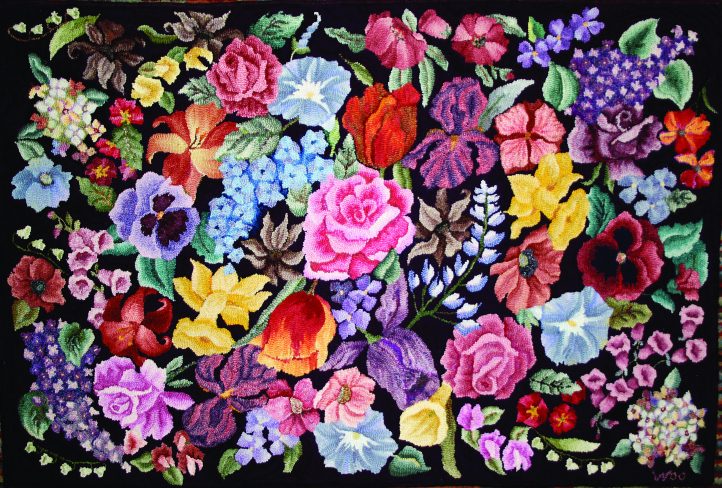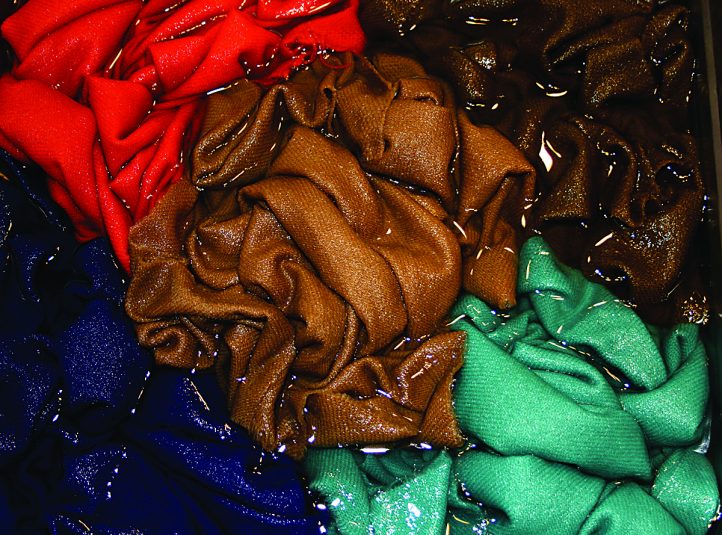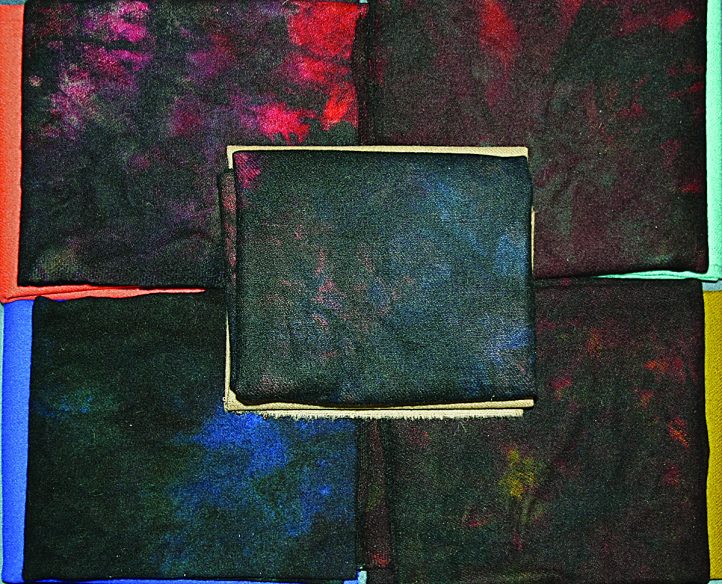
My English Garden, 31″ x 46″, #4-, 5-, and 6-cut wool on burlap. Pattern by Rittermere-Hurst-Field; hooked by Wanda Kerr, Wiarton, Ontario, 2000.
Let’s say you’ve been dyeing for a while—maybe even quite a while—and you’ve begun to feel stuck. You might be making the same colors repeatedly—purposely or accidently. You might be frustrated or bored every time you haul out the pots. You might even be ready to throw in the dye spoons and give it all up.
Would a troubleshooting guide be of benefit? You are going to be surprised how easy it is to become a much better dyer.
My English Garden is the first rug I dyed for; that is when I started really understanding dyeing and what I could do. I did one type of flower at a time, starting with roses and ending with hydrangeas. You can see the inventive differences; you have to start somewhere!
Problem:
I’m always making the same colors.
Solutions:
- Get a new dye formula book.
- Don’t use a formula book at all.
- Buy a few new colors and substitute them. For example: Use a new blue for the one in the recipe.
- Substitute orange for red in a formula, or purple. Look to the neighbors on the color wheel for inspiration.
- Buy a dye book with colors you are not used to using: If you are comfortable with brights, look for pastels. If you like intense colors, consider using colonial-style colors.
- Combine two recipes from different books on one piece of wool.
- Separate the colors from a single-color-result recipe into a spot dye.
- If you have lots of warm colors of dye, get some cool ones.
- Dye your favorite colors over odd-colored wool for a new version of what you like.

This is a collection of 5 different 1/4-yard samples to be overdyed.
Problem:
Nothing turns out the way it should.
Solutions:
- Relax. You don’t always need to match the dyed samples that are sold with books.
- Do your own samples of your dyes over your own wool in your kitchen. This visual reference will help you develop an eye and aid you as you create colors and implement your dyeing to suit your needs.
Problem:
I’m bad at measuring wool, so nothing turns out the way it should is very hard to judge the amount of wool to use. A half yard can be ripped off the bolt many ways, and it is not always equal depending on the system you use. Measuring by weight of the wool is a much better, more accurate, way to measure wool. Normally we are dyeing wool that weighs about 12 oz. per yard; 1 yard of Dorr natural weighs 12.5 oz.
So let’s say the recipe says dye over 1/4 yard. All you need to do is divide 12 oz. by 4 to get the proper amount of wool, or 3 oz. You now know that recipe will dye 3 oz. of wool no matter the size or shape. I use a little digital scale that cost me just $7.
Problem:
My wool is not interesting.
Solutions:
- If you think of something, try it. That’s your intuition nudging you. Go for it.
- Don’t be afraid to add something else or even more of what you’ve already used.
- Why stop at applying one or two similar colors? Layer up! Call on the old adage that more is more.
For instance, do you need a more interesting soft black, aka antique black? Find a collection of four colors of wool in similar values. In my sample, I used 5 different 1/4 yard pieces. One is a bit darker, one is a bit lighter; we don’t all have perfectly coordinated stashes.
Wanderful Black
Wet your wool and, while you do so, carefully consider which color of your dye should be the opposite each color. In my sample, I placed the tan piece in the middle so it could receive dye from all corners.
Amend your measures to accommodate what you know about your dyes. For example, one dye might be extra strong while another dye is notoriously weak. Since I want to use two dyes to make a combination, I need to use my knowledge from my dyed samples.
Here is what I used:
- I use 1/2 tsp. of dye in 1 c. of water per formula.
- I added 1/4 tsp. citric acid to each cup. Dark colors need this.
- Over the orange wool, I used 1/2 tsp. Majic Carpet Blue.
Solution:
Most people who write dye books work the recipes out over a standard measure of wool. There is a way to cut the wool off the bolt so the recipe and your wool size correspond, which is a good system until you start dyeing remnants or recycled wool. That’s when it gets tricky — it is very hard to judge the amount of wool to use. A half yard can be ripped off the bolt many ways, and it is not always equal depending on the system you use. Measuring by weight of the wool is a much better, more accurate, way to measure wool. Normally we are dyeing wool that weighs about 12 oz. per yard; 1 yard of Dorr natural weighs 12.5 oz.
So let’s say the recipe says dye over 1/4 yard. All you need to do is divide 12 oz. by 4 to get the proper amount of wool, or 3 oz. You now know that recipe will dye 3 oz. of wool no matter the size or shape. I use a little digital scale that cost me just $7.
Problem:
My wool is not interesting.
Solutions:
- If you think of something, try it. That’s your intuition nudging you. Go for it.
- Don’t be afraid to add something else or even more of what you’ve already used.
- Why stop at applying one or two similar colors? Layer up! Call on the old adage that more is more.
For instance, do you need a more interesting soft black, aka antique black? Find a collection of four colors of wool in similar values. In my sample, I used 5 different 1/4 yard pieces. One is a bit darker, one is a bit lighter; we don’t all have perfectly coordinated stashes.
Wanderful Black
Wet your wool and, while you do so, carefully consider which color of your dye should be the opposite each color. In my sample, I placed the tan piece in the middle so it could receive dye from all corners.

Arrange the wool in the dye bath.
Amend your measures to accommodate what you know about your dyes. For example, one dye might be extra strong while another dye is notoriously weak. Since I want to use two dyes to make a combination, I need to use my knowledge from my dyed samples.

Dye is poured over the wool.

The results of our experiment—Wanderful Black. If these colors are too warm for you, add blue or blue/bottle green and more black.
Here is what I used:
- I use 1/2 tsp. of dye in 1 c. of water per formula.
- I added 1/4 tsp. citric acid to each cup. Dark colors need this.
- Over the orange wool, I used 1/2 tsp. Majic Carpet Blue.
- Over the blue wool, I used 1/2 tsp. Majic Carpet Orange.
- Over the light turquoise wool, I used 1/4 tsp. Majic Carpet Red and Majic Carpet Orange.
- Over the yellow green wool, I used 1/4 tsp. of Majic Carpet Red Violet. The tan wool received a blessing of dye from each cup in the corner closest to section being dyed.
It will not surprise you that I don’t want you to do any stirring whatsoever. If the colors you poured made something strange, so be it. Remember, if you are looking for interesting wool, you have to let it be. Wait for the water to clear.
Turn all the wool over so that what was on the bottom is now facing up. Work gently. Don’t splash yourself. You will see patches of the original color. Great! The next step will create even more interest.
- Prepare 1 tsp. of Majic Carpet Black in 2 c. of water with 1/4 tsp. citric acid.
- Pour over all wool and poke the wool down with a chop or paint stir stick.
- Leave it for 5 minutes to take up the dye, and then you can stir!
- Take a look. Are some spots too bright and shiny for you? Dip a chopstick in your dry unifying color—in this case black—and dip it onto the spots, swirling the water around. Wait again for the water to clear.
Rinse well. Dry the wool in the dryer or hang it up to dry.
The result is a splendid collection!
The blue wool of course is making a very dark dark: use that for a shadow in a background or border. I used solid colors, but you can use textures, pastels, or pieces that you’ve already dyed and don’t like or don’t want to use. And you don’t have to make it dark. You can use way less dye each time and a unifying color at the end—and that can be any color. Develop your own special way with this dye recipe. And don’t be afraid to add more black if you need it!
Problem:
I’m frustrated.
Solutions:
- Get a dyeing buddy for support, one who is like-minded and wants to approach dyeing the same way you do.
- Make sure you have time to dye without distraction.
- Keep your equipment simple and handy.
- If waiting is a problem, get two pots going.
- Have two water kettles at boiling and a jug of water ready for adding to your dye baths or cups of formula.
- Hook while you dye. Try not to stir and fuss; just walk away.
- Give yourself the kindest treatment—a supportive environment for your happy learning curve.
Problem:
I am tense.
Solution:
Worrying about wasting or ruining wool is very restricting. When you learned to write you used a lot of sheets of paper. Were they wasted? You can always do something with wool—no matter how it turns out. Even it is black, you can still influence its temperature.
Nothing can really go terribly wrong. The worst scenario: You burn yourself.
Problem:
I feel unsure.
Solution:
Remember that if you can boil water, you can dye. You can do anything you desire, but you need to stop watching, reading, and talking—and get doing. You are your own guru; only you can make it happen.
Problem:
I make such a mess.
Solutions:
- Get organized.
- Try some containment. Get a basket or cart, a closet or a room to accommodate your needs for storage.
- Use rubber mats on the floor where you stand to dye, both for comfort and for controlling splashes or spills.
- Have some old rags handy, like a towel, to clean up a spill.
- Find a pan, bucket, pail, or other conveyance to carry wool from the soaking sink to the dye bath.
- Use a damp piece of wool as a cloth station on which to measure your dyes.
Problem:
Dyeing stinks or leaves me breathless.
Solution:
Use citric acid crystals instead of vinegar.
Problem:
I can’t get my dyes to take up.
Solutions:
- Leave it overnight.
- Have patience. Go do something else.
- Different dyes require different levels of acidity. You will acquire this type of knowledge through time as you dye samples. If your yellow is not taken up in a timely fashion, it might be better to not add acid until 95% of the dye is taken up. I have just begun this practice with excellent results.
- Synthropol or a wetting agent some-times helps.
- Agitation can work, but time works best and requires less effort.
Problem:
My dyes won’t dissolve when being mixed.
Solution:
Sometimes, even when my kettle is boiling furiously, some dyes won’t dissolve easily. Popping it into the microwave for 15 seconds or so will help. Get a little whisk and stir the solution vigorously.
Problem:
Everything I make is the same value.
Solutions:
- Use way more dye.
- Use way less dye.
- Put away your usual dye spoon and sub in another when you use your favorite formulas: for example, use 1/128 tsp. instead of 1/32 tsp.
- Start with factory-dyed wool to over-dye.
- Use another system of measures: toothpick, skewer, chopstick, paint stir stick.
- Remember that doubling a recipe will only change a color by one value. This change is not enough for contrast, but it’s great for blending.
If I were you, here’s what I’d do:
- Buy 5 yards of wool as soon as you can. Dedicate it to your dyeing education. It is better than any book you will ever buy.
- Get yourself a watercolor journal. Record your dyeing experiments there. You do not need to use wool to make an entry; just paint your formula on. This way you can easily see the changes your adaptations make. It is a good gift to yourself or a dyeing friend.
- Make test strips of the dyes you use most: 1/32 yard of wool dyed with 1/32 tsp. of dye makes a full saturation sample. If you want smaller samples, use 1/64 yard of wool with 1/64 tsp. dye.
- Play and play and play until your 5 yards of wool are gone! You will be a dyeing genius, your very own guru.
Well done.
